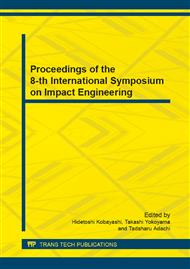p.542
p.548
p.554
p.563
p.569
p.575
p.581
p.586
p.593
Energy Absorption of Thin-Walled Beams with a Pre-Folded Origami Pattern
Abstract:
The bumper beam of a transport vehicle conventionally is commonly made from thin-walled materials with a shallow curved profile, with either opened or closed cross sections. Upon lateral crushing, it fails in a bending collapse mode characteristic of formation of a limited number of plastic hinges along the beam. This paper presents a novel structure known as the origami beam. It is a thin-walled shallow curved beam of square cross section whose surface is pre-folded according to an origami pattern. The origami pattern serves as a mode inducer to trigger a collapse mode that is more efficient in terms of energy absorption. Numerical simulation of the beam subjected to quasi-static lateral loading shows that a new collapse mode, referred to as the longitudinal folding mode featuring shortening of beam in the longitudinal direction prior to the formation of plastic hinges, can be triggered by the pre-folded origami pattern, leading to higher energy absorption and lower peak force than those of conventional ones. An increase in specific energy absorption (ratio between energy absorption and weight of the structure) of 23.6% being achieved in an optimum case, while the peak force is also reduced by 12.9%. Our work demonstrates that applying origami patterns to shallow curved thin-walled beams can effectively induce new collapse modes on the structures and increase the energy absorption capability.
Info:
Periodical:
Pages:
569-574
Citation:
Online since:
June 2014
Authors:
Keywords:
Price:
Сopyright:
© 2014 Trans Tech Publications Ltd. All Rights Reserved
Share:
Citation:


